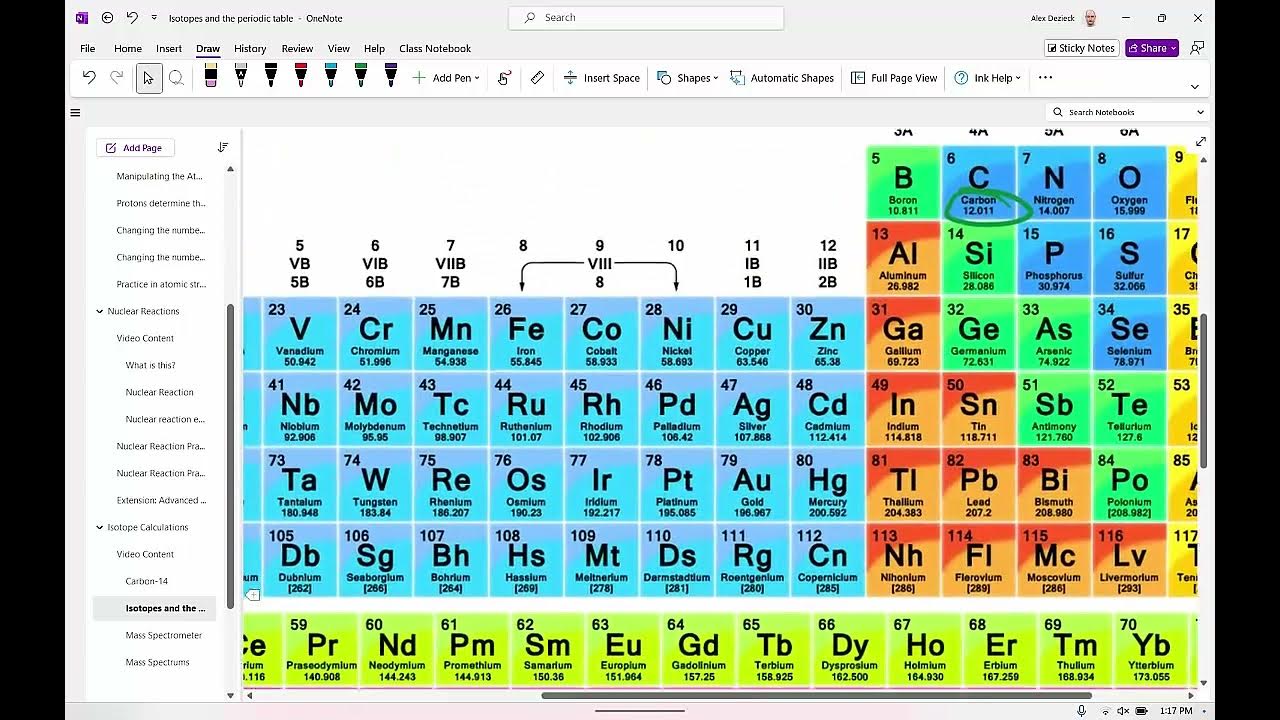2.2 The Mass Spectrometer
Summary
TLDRThis video explains the functioning of a mass spectrometer, a crucial tool in chemical analysis. The process involves five stages: vaporizing, ionizing, accelerating, deflecting, and detecting the sample. The key focus is on how ions are deflected by electromagnets, with the path determined by their mass-to-charge ratio. The data recorded allows for the identification of different isotopes and the calculation of atomic masses. The video further demonstrates how to interpret mass spectrometer data, using rubidium and boron as examples to calculate atomic mass and isotope abundances.
Takeaways
- 😀 A mass spectrometer is a vital instrument used in chemical analysis.
- 😀 The mass spectrometer works in five stages: vaporization, ionization, acceleration, deflection, and detection.
- 😀 The deflection of ions in the mass spectrometer is influenced by their mass-to-charge ratio.
- 😀 Electromagnets are used in the deflection stage to alter the ions' path.
- 😀 The amount of deflection depends on the ion's charge and mass-to-charge ratio.
- 😀 Different ions with varying mass-to-charge ratios will take different paths during deflection.
- 😀 The detected data represents the mass-to-charge ratios of ions in the sample.
- 😀 By repeating the process with the same sample, mass spectrometer data provides a breakdown of the different ion fragments.
- 😀 The script uses rubidium as an example to calculate average atomic mass from its mass spectrometer data.
- 😀 The example with boron isotopes demonstrates how to calculate the relative abundance of isotopes using mass spectrometer data.
- 😀 The abundance percentages of isotopes can be used to calculate the average atomic mass of an element.
Q & A
What are the five stages involved in the operation of a mass spectrometer?
-The five stages involved in the operation of a mass spectrometer are: 1) vaporization of the sample, 2) ionization of the sample, 3) acceleration of the ions, 4) deflection of the ions, and 5) detection of the ions.
Why is the deflection stage considered the heart of the mass spectrometer?
-The deflection stage is considered the heart of the mass spectrometer because it is where ions are manipulated based on their mass-to-charge ratio. This allows the mass spectrometer to distinguish between different ions and measure their characteristics.
How does the mass-to-charge ratio influence the path of an ion in a mass spectrometer?
-The mass-to-charge ratio influences the path of an ion in a mass spectrometer because ions with different mass-to-charge ratios will experience different degrees of deflection when exposed to an electromagnetic field. This leads to different paths, which are then detected to determine their properties.
What role do electromagnets play in the operation of a mass spectrometer?
-Electromagnets are used in the mass spectrometer to create a magnetic field that deflects the ions as they move through the device. The force of the deflection depends on the charge of the ion, allowing the spectrometer to separate ions based on their mass-to-charge ratio.
What is the importance of detecting the mass-to-charge ratio in mass spectrometry?
-Detecting the mass-to-charge ratio is crucial because it allows scientists to identify the specific isotopes and molecules present in a sample, determine their abundance, and calculate average atomic masses.
How can the mass spectrometer help in determining the atomic mass of rubidium?
-In the case of rubidium, the mass spectrometer data shows the relative abundances of the rubidium isotopes (rubidium-85 and rubidium-87). By multiplying the percentage of each isotope by its mass and averaging them, the average atomic mass of rubidium can be calculated.
How do you calculate the relative abundance of isotopes in a sample using mass spectrometer data?
-To calculate the relative abundance of isotopes, you set up an equation based on the number of atoms of each isotope. For example, if you have 100 atoms of boron, let the number of boron-10 atoms be X and the number of boron-11 atoms be 100 - X. By using the known average atomic mass and solving for X, you can find the relative abundance of each isotope.
What mathematical method is used to calculate the relative abundance of isotopes, as demonstrated with boron?
-The calculation involves algebraic methods. By using the known average atomic mass of boron and setting up an equation that represents the total mass of the sample, you can solve for the number of atoms of each isotope, thereby determining their relative abundances.
What does the term 'mass-to-charge ratio' mean in the context of mass spectrometry?
-The mass-to-charge ratio (m/z) refers to the ratio of an ion's mass to its electric charge. This ratio determines how much an ion is deflected by the magnetic field in the mass spectrometer, which is used to identify and measure the ion.
How does the concept of momentum relate to the deflection of ions in a mass spectrometer?
-Momentum in mass spectrometry refers to an ion's tendency to continue moving in a straight line. The greater the ion's mass, the more momentum it has, and the less it will be deflected by the magnetic field. This relationship is crucial for distinguishing ions based on their mass-to-charge ratio.
Outlines

このセクションは有料ユーザー限定です。 アクセスするには、アップグレードをお願いします。
今すぐアップグレードMindmap

このセクションは有料ユーザー限定です。 アクセスするには、アップグレードをお願いします。
今すぐアップグレードKeywords

このセクションは有料ユーザー限定です。 アクセスするには、アップグレードをお願いします。
今すぐアップグレードHighlights

このセクションは有料ユーザー限定です。 アクセスするには、アップグレードをお願いします。
今すぐアップグレードTranscripts

このセクションは有料ユーザー限定です。 アクセスするには、アップグレードをお願いします。
今すぐアップグレード関連動画をさらに表示

Espectrometria de Massas (Vídeo 1: Instrumentação)

A Level Chemistry Revision "The Mass Spectrometer"

Lecture 60: Sampling and Analysis of PM10 & PM2.5 using Spectrometer

Part-1. Mass spectrometry | ch#1(Basic concepts) | 11th class Chemistry

Isotopes and Mass Spectrums

Hukum Lavoisier (Hukum Kekekalan Massa) | Kimia SMA | Tetty Afianti
5.0 / 5 (0 votes)
